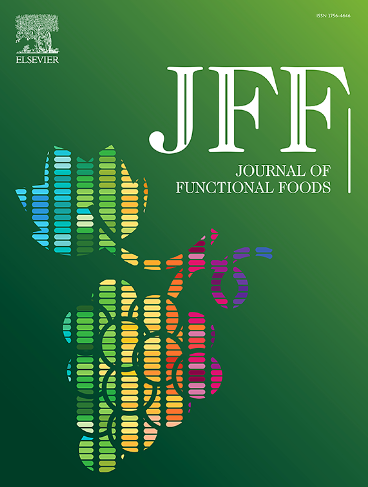α-细辛酮(α-细辛酮)与多奈哌齐协同减轻氯化铝所致大鼠阿尔茨海默病的研究。
IF 4
2区 农林科学
Q2 FOOD SCIENCE & TECHNOLOGY
引用次数: 0
摘要
α-细辛酮(α-细辛酮)及其联合多奈哌齐(Dnp)通过调节胆碱能活性、突触可塑性、神经炎症和氧化应激,同时降低a- β1 - 42聚集,显示出显著的治疗阿尔茨海默病(AD)的潜力。本研究评估了α-细辛酮(3.6 mg/kg,每日一次)和Dnp (1 mg/kg,每日一次)单独和联合对三氯化铝(4.2 mg/kg,每日一次,连续28天)诱导的AD大鼠模型的神经保护作用。通过Morris水迷宫和被动回避测试评估,这些治疗改善了空间学习和记忆,降低了乙酰胆碱酯酶、β-分泌酶、a - β1 - 42和炎症标志物。分子对接研究表明,α-细辛酮与AChE、BACE1、TNF-α和IL-6具有较强的结合亲和力。组织病理学分析显示海马锥体细胞和皮层结构的恢复。研究表明,α-细辛酮单独使用或与Dnp联合使用,具有神经保护、抗氧化和抗炎作用,是一种很有前景的治疗AD的方法。因此,本研究结果为α-细辛酮的剂量(3和6 mg/kg;p.o.)和多奈哌齐(1mg /kg;在啮齿类动物的安全范围内,并对应于人类等效水平,从而支持未来转化研究的进展。本文章由计算机程序翻译,如有差异,请以英文原文为准。

Synergistic approach of alpha-Asarone (α-asarone) with donepezil in mitigating Alzheimer's disease induced by Aluminium chloride in rats.
Alpha-asarone (α-asarone) and its combination with donepezil (Dnp) exhibit significant therapeutic potential against Alzheimer's disease (AD) by modulating cholinergic activity, synaptic plasticity, neuroinflammation, and oxidative stress while reducing Aβ1–42 aggregation. The present study evaluated the neuroprotective effects of α-asarone (3, 6 mg/kg, p.o.) and Dnp (1 mg/kg, i.p.), individually and in combination, in a rat model of AD induced by aluminium trichloride (4.2 mg/kg, i.p., for 28 days). The treatments improved spatial learning and memory, as assessed by the Morris water maze and passive avoidance tests, and decreased acetylcholinesterase, β-secretase, Aβ1–42, and inflammatory markers. Molecular docking studies demonstrated α-asarone's strong binding affinity to AChE, BACE1, TNF-α, and IL-6. Histopathological analysis revealed restoration of hippocampal pyramidal cells and cortical structures. The study suggests α-asarone, alone or in combination with Dnp, offers neuroprotective, antioxidant, and anti-inflammatory benefits, presenting a promising therapeutic approach for AD management. Thus, the findings of this study provide a framework for the dosages of α-asarone (3 and 6 mg/kg; p.o.) and donepezil (1 mg/kg; i.p.), which are within the safety limits for rodents and correspond to human-equivalent levels, thereby supporting the advancement of future translational research.
求助全文
通过发布文献求助,成功后即可免费获取论文全文。
去求助
来源期刊

Journal of Functional Foods
FOOD SCIENCE & TECHNOLOGY-
CiteScore
9.60
自引率
1.80%
发文量
428
审稿时长
76 days
期刊介绍:
Journal of Functional Foods continues with the same aims and scope, editorial team, submission system and rigorous peer review. We give authors the possibility to publish their top-quality papers in a well-established leading journal in the food and nutrition fields. The Journal will keep its rigorous criteria to screen high impact research addressing relevant scientific topics and performed by sound methodologies.
The Journal of Functional Foods aims to bring together the results of fundamental and applied research into healthy foods and biologically active food ingredients.
The Journal is centered in the specific area at the boundaries among food technology, nutrition and health welcoming papers having a good interdisciplinary approach. The Journal will cover the fields of plant bioactives; dietary fibre, probiotics; functional lipids; bioactive peptides; vitamins, minerals and botanicals and other dietary supplements. Nutritional and technological aspects related to the development of functional foods and beverages are of core interest to the journal. Experimental works dealing with food digestion, bioavailability of food bioactives and on the mechanisms by which foods and their components are able to modulate physiological parameters connected with disease prevention are of particular interest as well as those dealing with personalized nutrition and nutritional needs in pathological subjects.
 求助内容:
求助内容: 应助结果提醒方式:
应助结果提醒方式:


